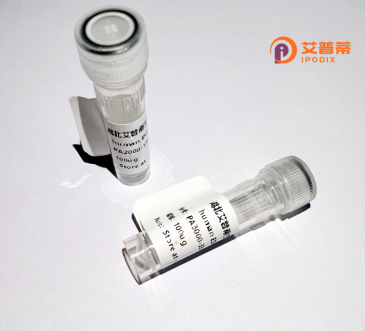
| 纯度 | >90%SDS-PAGE. |
| 种属 | Human |
| 靶点 | PRKAR2A |
| Uniprot No | P13861 |
| 内毒素 | < 0.01EU/μg |
| 表达宿主 | E.coli |
| 表达区间 | 2-404 aa |
| 活性数据 | SHIQIPPGL TELLQGYTVE VLRQQPPDLV EFAVEYFTRL REARAPASVL PAATPRQSLG HPPPEPGPDR VADAKGDSES EEDEDLEVPV PSRFNRRVSV CAETYNPDEE EEDTDPRVIH PKTDEQRCRL QEACKDILLF KNLDQEQLSQ VLDAMFERIV KADEHVIDQG DDGDNFYVIE RGTYDILVTK DNQTRSVGQY DNRGSFGELA LMYNTPRAAT IVATSEGSLW GLDRVTFRRI IVKNNAKKRK MFESFIESVP LLKSLEVSER MKIVDVIGEK IYKDGERIIT QGEKADSFYI IESGEVSILI RSRTKSNKDG GNQEVEIARC HKGQYFGELA LVTNKPRAAS AYAVGDVKCL VMDVQAFERL LGPCMDIMKR NISHYEEQLV KMFGSSVDLG NLGQ |
| 分子量 | 45.5 kDa |
| 蛋白标签 | His tag N-Terminus |
| 缓冲液 | PBS, pH7.4, containing 0.01% SKL, 1mM DTT, 5% Trehalose and Proclin300. |
| 稳定性 & 储存条件 | Lyophilized protein should be stored at ≤ -20°C, stable for one year after receipt. Reconstituted protein solution can be stored at 2-8°C for 2-7 days. Aliquots of reconstituted samples are stable at ≤ -20°C for 3 months. |
| 复溶 | Always centrifuge tubes before opening.Do not mix by vortex or pipetting. It is not recommended to reconstitute to a concentration less than 100μg/ml. Dissolve the lyophilized protein in distilled water. Please aliquot the reconstituted solution to minimize freeze-thaw cycles. |
以下是关于重组人PRKAR2A蛋白的3篇模拟参考文献示例(实际文献需通过学术数据库查询):
---
1. **标题**:*Expression and Purification of Recombinant Human PRKAR2A in Escherichia coli*
**作者**:Chen L, et al.
**摘要**:研究描述了在大肠杆菌中高效表达可溶性重组人PRKAR2A蛋白的方法,并采用His标签亲和层析纯化,为后续功能研究提供材料基础。
2. **标题**:*PRKAR2A Modulates cAMP/PKA Signaling in Cardiac Hypertrophy*
**作者**:Kimura T, et al.
**摘要**:通过体外实验证明PRKAR2A通过调节cAMP-PKA通路影响心肌细胞肥大,敲低PRKAR2A可减轻病理表型,提示其在心脏疾病中的调控作用。
3. **标题**:*Structural Insights into PRKAR2A Interaction with Protein Kinase A*
**作者**:Miller S, et al.
**摘要**:利用X射线晶体学解析PRKAR2A与PKA催化亚基复合物结构,揭示其抑制催化活性的分子机制,为靶向药物设计提供依据。
---
建议通过 **PubMed** 或 **Google Scholar** 搜索实际文献,关键词如:"Recombinant PRKAR2A"、"PRKAR2A expression" 或 "PRKAR2A function"。
PRKAR2A (Protein Kinase cAMP-Dependent Type II Regulatory Subunit Alpha) is a crucial component of the cAMP-dependent protein kinase A (PKA) signaling pathway. As a regulatory subunit, it binds to catalytic subunits of PKA, forming an inactive tetramer in the absence of cyclic AMP (cAMP). Upon cAMP elevation, PRKAR2A undergoes conformational changes, releasing active catalytic subunits that phosphorylate downstream targets, regulating processes like metabolism, gene expression, and cell proliferation. Structurally, it contains two cAMP-binding domains, a dimerization/docking domain, and a pseudosubstrate region critical for autoinhibition.
The PRKAR2A gene is located on chromosome 3p21.31 and encodes two major isoforms via alternative splicing. It is widely expressed, with notable abundance in brain, heart, and endocrine tissues. Dysregulation of PRKAR2A is linked to diseases like Carney complex (a genetic disorder causing tumors in endocrine glands and heart), obesity, and certain cancers. Mutations often disrupt PKA signaling, leading to uncontrolled cell growth or hormonal imbalances.
Recombinant human PRKAR2A is produced using bacterial or mammalian expression systems for research applications. It serves as a tool to study cAMP/PKA pathways, protein interactions, and the functional impact of disease-associated mutations. Its purification typically involves affinity tags (e.g., GST or His-tag), enabling studies on phosphorylation dynamics, enzyme kinetics, and drug screening targeting PKA-related disorders.
×